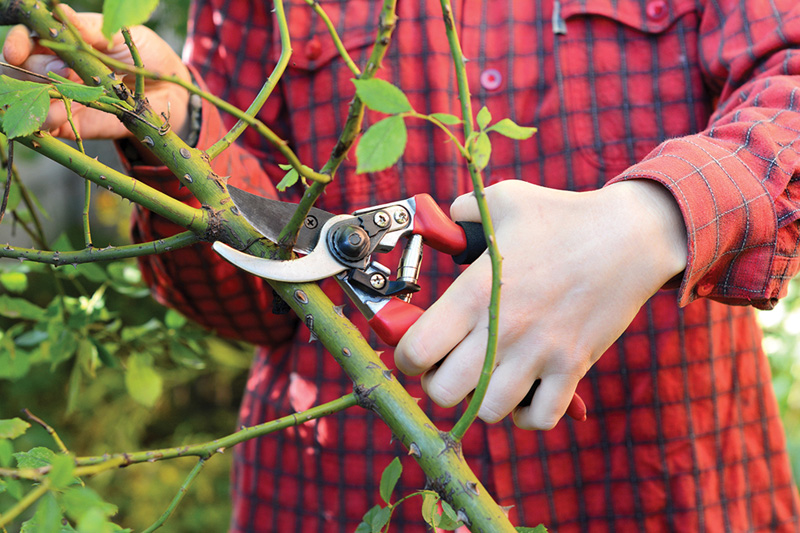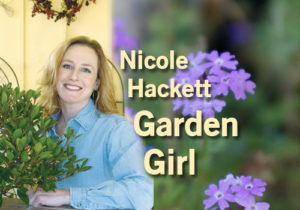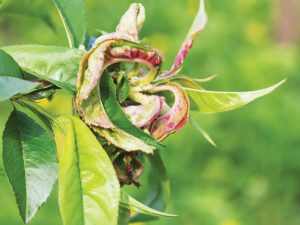
Prune roses now, then top off with special rose fertilizer
 CLAYTON, CA (Jan. 25, 2024) — Although January can be cold and wet, there are timely garden chores that need to be done.
CLAYTON, CA (Jan. 25, 2024) — Although January can be cold and wet, there are timely garden chores that need to be done.
It’s the time of year to focus on your roses, deciduous fruit trees and acid-loving shrubs.
Prune rose bushes, groundcover roses and rose trees now. If you prune annually, it should take less than five minutes per bush.
As you approach a rose bush to prune, look right to the bottom of the plant. Do not worry about all the buds, blooms or leaves still left on the bush – begin at the bottom.
A well-pruned hybrid tea, grandiflora or floribunda rose should have three to five straight, clean canes without any leaves. The object of pruning is to remove most of the past year’s growth, all the crossing canes and lateral branches.
Make all your cuts at a slight angle, right before a swelling of growth. If you look closely at a rose cane before you make the cut, you will see a seam with a swell. This is where the rose wants to grow.
I do not tell people how many inches of cane to leave on a rose, because it depends on the amount of room you have for your rose to grow. If you have limited space, then cut each cane farther back. If you like your roses tall, then do not cut down as far.
Prune rose trees the same way as rose bushes. Remove old canes, crossing branches and lateral branches. With rose trees, leave more canes so they will look fuller.
Groundcover roses such as drift, carpet roses or mediland style do not need the same amount of attention. Reshape groundcover roses, bringing them down and in. If the groundcover style roses are out of control, prune severely. With a newer installation, the pruning will be lighter.
The Garden Girl’s rose recipe
Fertilizing roses is especially important. I have been sharing this recipe for more than a decade. Apply this after your winter prune to established ground-grown hybrid tea, grandiflora, floribunda or tree-shaped roses.
Each rose is to receive:
½ c. 16-16-16 multi-purpose fertilizer
½ c. bone meal
½ c. granular iron
½ c. alfalfa meal
Work into soil along drip line and top-dress with an inch layer of chicken manure. Water in.
Container roses get half a dose of each product. Give groundcover roses only the multi-purpose fertilizer and iron.
This sounds like a lot of products but imagine how deep the roots of your rose are. Do not premix a batch of products. There is a reason for each ingredient and the quantity.
The 16-16-16 multi-purpose fertilizer acts like a balanced meal. The bone meal is a source of phosphorus, encouraging bloom. Granular iron keeps your rose leaves green and free of chlorosis. Alfalfa meal will stimulate new cane growth.
Warding off peach leaf curl
 Since 2020, many folks have turned their backyards into orchards. They planted many varieties of stone fruit, all of which need to be sprayed now. Once the buds swell, spray again for peach leaf curl.
Since 2020, many folks have turned their backyards into orchards. They planted many varieties of stone fruit, all of which need to be sprayed now. Once the buds swell, spray again for peach leaf curl.
Yes, peach leaf curl affects more than just peaches. It presents in the late days of spring, when you may notice red or orange blistering on your foliage. Peach leaf curl is usually mild the first season but can come back strong if left untreated.
The only way to cure peach leaf curl is while the trees are dormant. Apply now and again once your peach, plum, nectarine or apricot has fat buds. Do not spray a tree that’s already in bloom.
January is also a good time to apply a dose of organic fruit tree fertilizer and top dress the soil beneath the drip line of the tree with either manure or earthworm castings. Fertilizer takes six weeks to activate and travels up the body of the tree, so it is OK to apply now. You won’t see any results until March.
Azaleas and camellias need two types of fertilizer currently. Use fertilizer for blooms such as 0-10-10 and a dose of granular iron to help plants green back up after the winter.
Blue mophead hydrangeas need an application of aluminum sulfate. This product is not a fertilizer, but rather a supplement to help your hydrangeas stay blue.
Resist the urge to prune or fertilize your hydrangeas until March. They are summer plants and should look poor this time of year.
Send comments/questions by email to gardengirl94517@yahoo.com

Nicole Hackett
Nicole is the Garden Girl at R&M Pool, Patio, Gifts and Garden. You can contact her with questions or comments by email at gardengirl94517@yahoo.com
